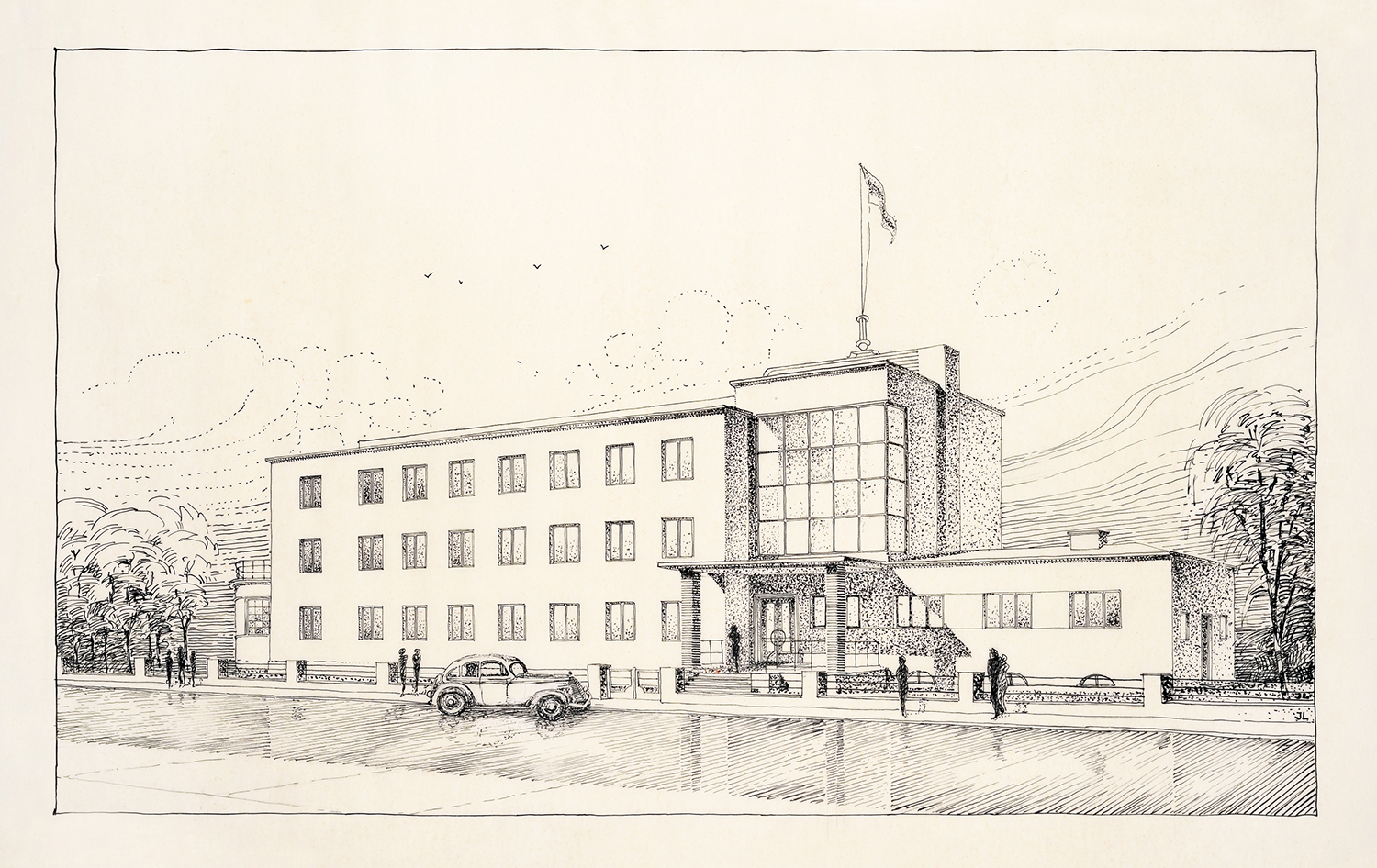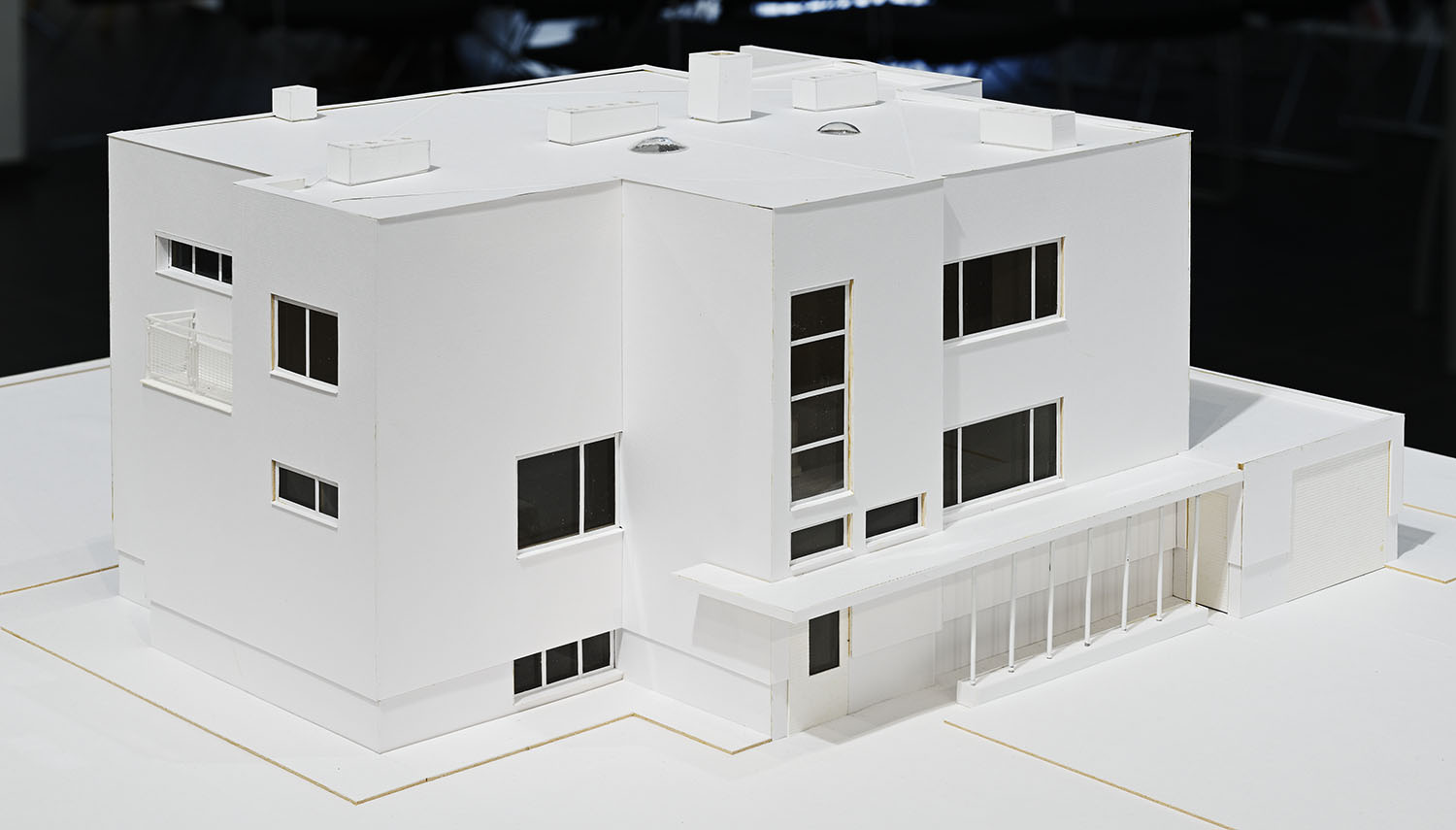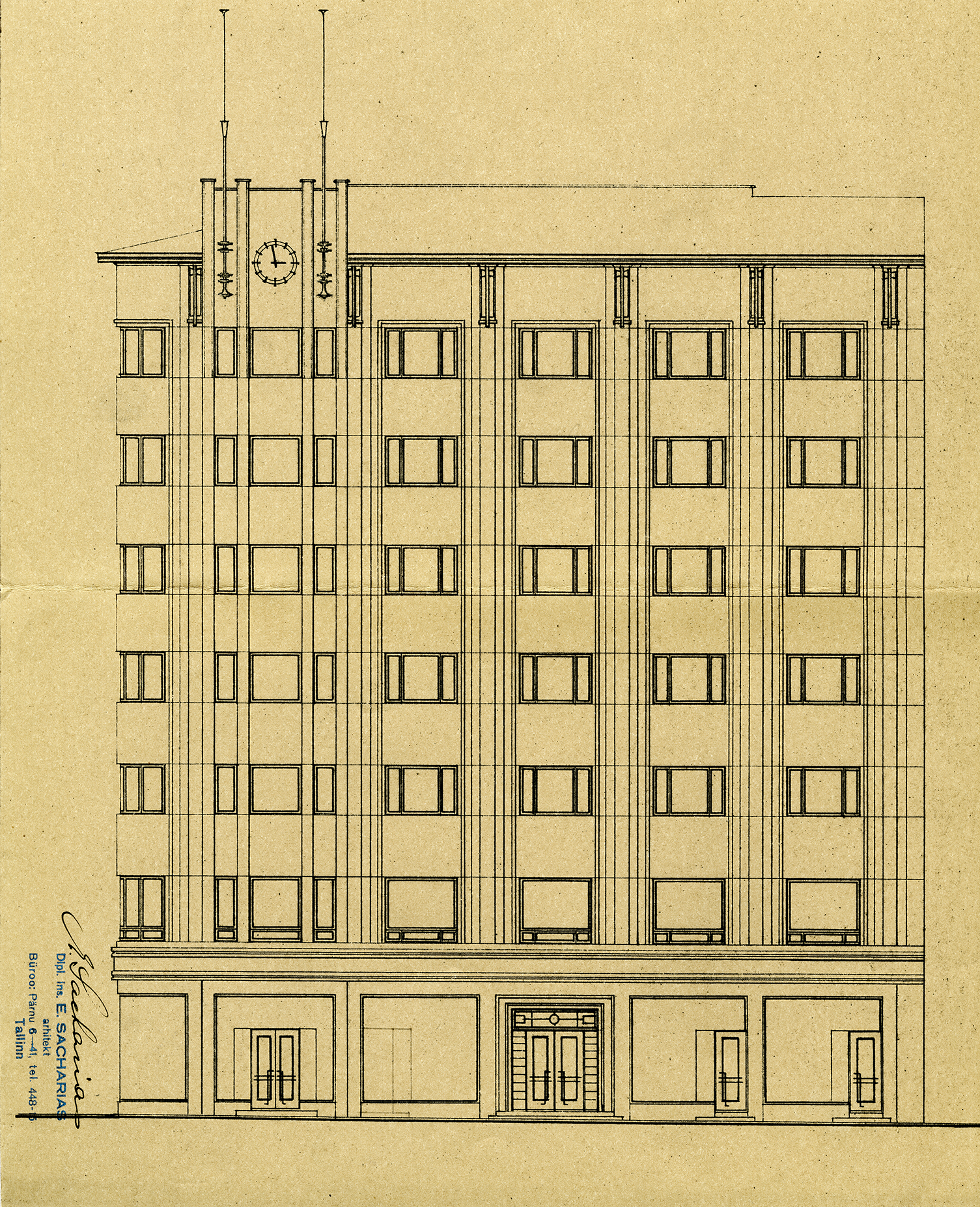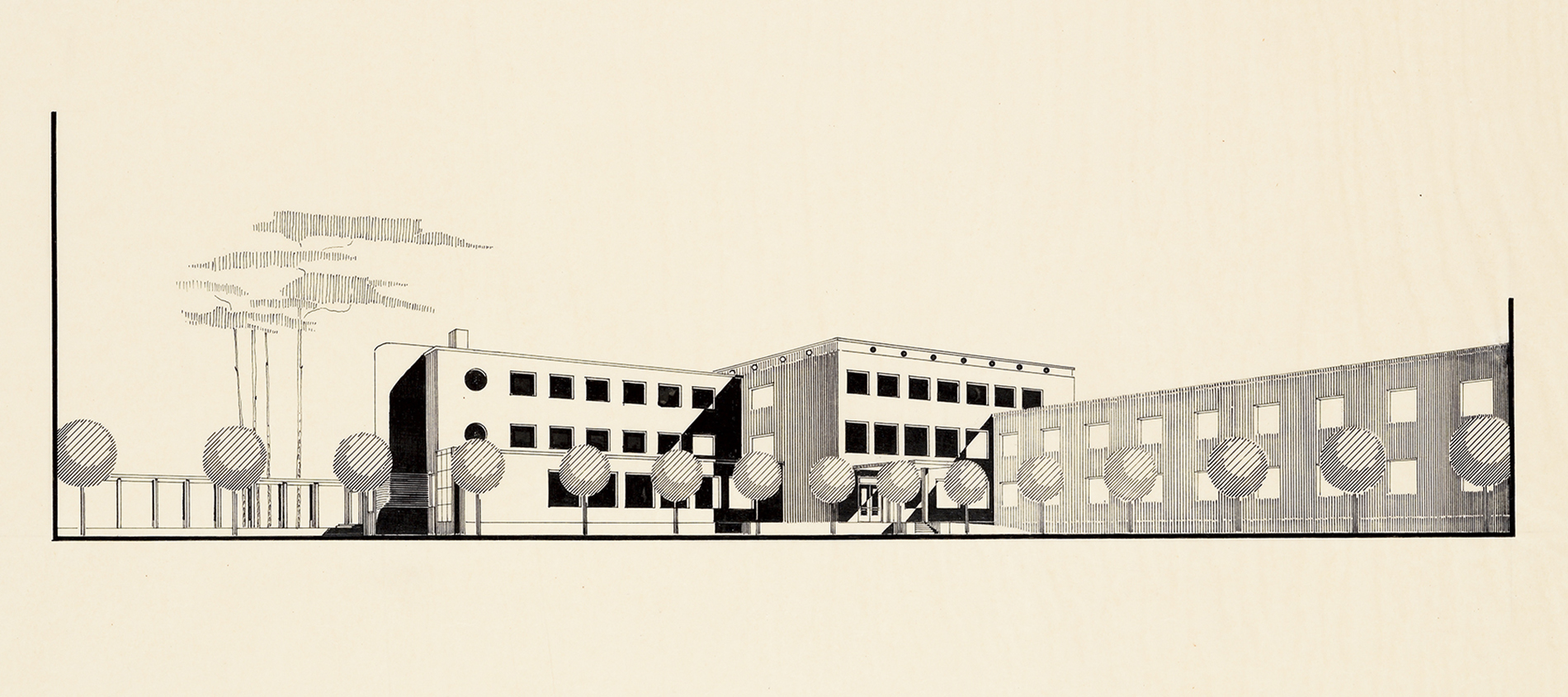Tag Archives: 1930s
Sanatorium named after General J. Laidoner in Haapsalu

August Volberg, 1936. EAM 31.1.13
The Estonian Red Cross sanatorium in Haapsalu, named after General Johan Laidoner, was designed by architect August Volberg. The building was completed in 1937. Built primarily for soldiers who had suffered in the War of Independence, the sanatorium had 41 double rooms and a spacious terrace with a sea view. The main architectural emphasis of the functionalist building is on the entrance and the glass wall of the stairwell above it. The high flagpole on the roof of the building and its distinctive curved base structure emphasise the importance of the sanatorium. The connection between the glass corner and the rest of the facade makes it possible to find links with the work of architect Walter Gropius in Germany. Text: Anna-Liiza Izbaš
Veel: 1930s, architect: August Volberg
Sketches of the facade of the Tallinn Art Hall

Anton Soans, Edgar Johan Kuusik, 1932-1933. EAM 16.1.39
Designed by architects Anton Soans and Edgar Johan Kuusik, the Tallinn Art Hall is one of the most outstanding examples of functionalism in Estonia. In order to find the most suitable facade design, the architects sketched different solutions – the drawings show different designs for the entrance to the building, the arrangement of windows and the details on the facade. The facade solution of the building also changed slightly during the construction works, when the initially planned round windows were replaced with vertical niches. The cornerstone of the Tallinn Art Hall was laid on August 29, 1933, and it was officially opened with an art exhibition on September 15, 1934. The modernity of the originally five-storey building with a T-shaped ground plan is emphasized by the main entrance of the building that is stepping back from the street line and the central part of the front facade that is resting on two pillars, as well as the flat roof of the building. The glass screen located in the middle of the facade, as if placed inside a frame, connects the artists’ studios, office spaces and exhibition hall located on different floors on the facade into one. In 1937, the bronze figures “Work” and “Beauty” designed by the sculptor Juhan Raudsepp were placed in the niches of the facade. According to the project of Edgar Johan Kuusik, the last floor of the Art Building was rebuilt in 1962, as a result of which the building became as high as the adjacent Art Foundation building (architect Alar Kotli). In 1993, Ado Soans, son of Anton Soans, donated the facade drawings to the museum. Text: Anna-Liiza Izbaš
(klick on the picture to see more illustrations)
Veel: 1930s, architect: Anton Soans, architect: Edgar Johan Kuusik
Mustamäe bathing facility

Tõnis Mihkelson, 1936. EAM 2.6.53
Under the lead of entrepreneur Johan Must, a bathing facility was built in Nõmme under the slope of Mustamäe. The town of Nõmme granted a construction permit for the facility in 1927, but the construction work was delayed due to land ownership disputes. In 1934, Johan Must acquired the necessary land. He received a loan from the Ministry of Economy to build a bathing facility, construction work began in the fall of 1935. Mustamäe bathing facility was designed by architect Tõnis Mihkelson. In 1936, a cafe building and a 50-meter swimming pool were completed. A year later, changing rooms, another slightly deeper pool, a water jumping tower and a swan pond were opened. In order to obtain a water temperature suitable for swimming, cold spring water was directed through four pre-heating pools, and artificial waterfalls were built to ensure water quality. A functionalist wooden cafe building was located between the two swimming pools. There were dressing rooms on the first floor, a balcony and a separate area for the orchestra on the second floor. In addition, a staircase was planned on the slope of Mustamäe, which led to Nõmme’s garden city. Domestic and international swimming competitions were held in the swimming pools, chess tournaments were regularly held in the cafe building. In winter, people could enjoy winter swimming and ice skating.The cafe building of the Mustamäe bathing facility was destroyed in 1974. Text: Anna-Liiza Izbaš
(klick on the picture to see more illustrations)
Veel: 1930s, architect: Tõnis Mihkelson
The War of Independence monument competition work “Mälestis-ehis”

Edgar Johan Kuusik, 1931. EAM 7.1.76
The story of the monument begins in the 1920s, when the statue of Peter I standing on the Freedom Square was taken down (1922) and it was decided to erect a statue of the War of Independence in its place. The construction of the monument delayed, and instead a massive limestone memorial-mausoleum designed by Edgar Johan Kuusik was erected at the Defence Forces Cemetery (1928). At the end of 1930, when the competition for the construction of a War of Independence monument on Harjumäe was announced, Edgar Johan Kuusik in cooperation with Elmar Lohk submitted two works for the competition. The competition entry with the keyword “Mälestis-ehis” repeats the same motif as the memorial-mausoleum in the cemetery – a massive cubic volume with four arches opening towards the four cardinal directions. However, the prize went to the authors’ second work “Pro Patria”. Later, Kuusik used the same style at the gate building of the Defence Forces Cemetery (1938). The competition work “Mälestis-ehis” was donated to the museum by the E. J. Kuusik family in 2021, the drawings were conserved in Conservation and Digitisation Centre Kanut. Text: Anne Lass
Veel: 1930s, architect: Edgar Johan Kuusik
Villa Tammekann in Tartu

Alvar Aalto, 1932. Maquette: Peet Veimer. EAM MK 47
February 3 is the 125th anniversary of the birth of the world-famous Finnish architect Alvar Aalto. The private residence of the University of Tartu professor August Tammekann at Kreutzwaldi st. 6 Tartu is the only completed building in Estonia designed by architect Aalto. The flat roofed, two-storey functionalist building was partially completed in 1933. According to the style’s principles, the building’s facade reflects the usage of the interior spaces. On the street side, a stairwell rises behind the vertical window, on the courtyard side, the central element is the wide ribbon window of the living room with a fireplace located at the bottom of the window. The flat roof of the house, which was not widespread at the time, caused a lot of discussion among the locals and was even considered as an anti-God phenomenon. The villa was rebuilt into an apartment building during the Soviet period. In 1994, the building was returned to Professor Tammekann’s offspring, in the 1998 University of Turku bought the building. The villa was restored according to Alvar Aalto’s project in 2000. Today, the Granö Centre of the universities of Turku and Tartu is located in the building.
The maquette of Villa Tammekann was made for the Estonian Architecture Museum exhibition “Aalto: three projects in Estonia” by Peet Veimer in 1998. Text: Anna-Liiza Izbaš
Veel: 1930s, architect: Alvar Aalto
The competition project of physical culture centre “Siseõu”. II prize

Erika Nõva, 1939. EAM 2.6.34
Sports and physical culture become the keywords of modern life in the mid-1930s. Planning a representative sports building in Tallinn become on the agenda. A suitable location was found in the Falkpark (today Falgi Park) located at Toompuiestee. In November 1938, the architectural competition was announced. The plan was grandiose: the building had to hold a main hall (20×40 m) for gymnastics, basketball and volleyball, tennis, wrestling, weightlifting and other fields. The stands had seats for 4,500 spectators. Another large room group consisted of a swimming pool (14×25 m) and two saunas, and the third was a gymnasium. In addition to training, dressing and washrooms, office spaces and apartments for officials were also planned. The international competition ended in April 1939. Finnish architects Enn Muistre and Einar Teräsvirta won the first prize, the third prize went to Latvian architect Arturs Reinfelds. Erika Nõva, one of the first female architects in Estonia, received the second prize. The award committee highlighted Nõva’s urban-planningly successful solution “… because the semicircular forms relate architecturally well to multi-directional streets.” The solution of the main hall, the swimming pool and the central part of the building was called magnificent / Eesti Arhitektuur. Varamu arhitektuuri osakond nr 3, 1939/. Erika Nõva recalls: “This job started to bother me. I thought I don’t deserve it, but I couldn’t give up the thought either. Little by little, I began to observe related examples from foreign magazines and tried to sketch it according to the program. When I showed these sketches to Kotli and Soans /… /, they encouraged me to continue working.” / Erika Nõva. Minu töö ja elu. Tallinn, 2006, p. 61/. What follows is a long and cheerful description of the work-hours at night, the draftsman’s assistant Tsinovski (Nopski), the nerve-wracking moments when sending off the work at the post office of Nõmme station, the victory celebration at the “Ehitaja” office and later at Mustamäe’s home. Text: Anne Lass
Veel: 1930s, architect: Erika Nõva
Lantern drawing of the President’s Office

Alar Kotli, 1938. EAM 2.9.2
The main entrance of the President’s Office is flanked by lanterns featuring abundant rosettes and leaf motifs which comprise an integral whole with the Neo-Baroque architecture. Seeing as this is a representative building, there are sockets for flag poles above the lanterns. The drawing also depicts a familiar motif from the coat of arms of Estonia – a bronze leopard (by sculptor Voldemar Mellik) set to guard the doorway on both sides. This pencil drawing was part of the colletion given to the museum in 1993 via firm Eesti Ehitusmälestised. Text: Sandra Mälk
Veel: 1930s, architect: Alar Kotli
Reconstruction of the Toompea Castle and the castle garden

Alar Kotli, 1933–1936. EAM 2.11.15
The aspiration for representability that began in the second half of the 1930s made its way to architecture via state buildings, manifesting in the use of traditional forms and details. The Estonian government, which had centred around Toompea, reconstructed the southern wing of Toompea Castle and the Governor’s Garden in front of it, opting for a Neo-Baroque style that harmonised with the 18th-century Late Baroque look of the front of the castle. The supporting wall of the Governor’s Garden also received a fresh look. The Coloured copy in watercolour technique was added to the museum collection in 1991. Text: Sandra Mälk
Veel: 1930s, architect: Alar Kotli
Office and Residential Building at Pärnu Road

Eugen Sacharias, 1936. EAM 2.2.320
The seven-storey building on the corner of Pärnu Road and Väike-Karja Street is one of the most representative rental houses built in the second half of the 1930s in the center of Tallinn. The project was commissioned from Eugen Sacharias (1906–2002) by the association “Elamu”. On the ground floor there were and still are business premises, on the first floor offices and on the higher floors there were multi-room apartments with all amenities, bathrooms and maid’s rooms. As there were several doctors among the tenants at that time, this house has also been called the so-called doctors’ house. On the seventh floor of the building were the offices of the architect Sacharias.
The Baltic-German architect Eugen Sacharias was born on April 21, 1906, who studied at the Technical University of Prague in 1925–1931. As a talented and enterprising young architect, he first helped Eugen Habermann design the so-called Urla House on 10 Pärnu Road, after which he founded his own office. In the following ten years almost 40 apartment building projects were completed. That shaped the representative visual of Tallinn as the capital. In 1941, Sacharias left to Germany with his family and ended up in Australia, where he continued to work as an architect in a construction company. In April 1991, Eugen Sacharias’ 85th birthday was celebrated with an exhibition in the lobby of the Library of the Academy of Sciences (now the Tallinn University Library). The exhibition was curated by art historian Mart Kalm. This was the first exhibition of the Estonian Museum of Architecture, founded three months earlier.
Text: Anne Lass
Veel: 1930s, architect: Eugen Sacharias, Tallinn
Competition entry for the tuberculosis sanatorium in Taevaskoda

August Volberg, Edgar Velbri, 1935. EAM 31.1.66
Sanatoriums were part of a healthy lifestyle that was promoted in the 1930s. Untouched natural environments started to be taken under protection as well as Taevaskoda in Põlva County in 1935. The architecture competition for skeletal TB sanatorium, held soon after, aimed to find a building fitting the environment to serve as a health institution. The first prize was given to a pair of renowned architects. Prominent shadows and a strong ink line in the drawing indicate that they were influenced by modern industry and technology. The building was designed for 90 patients and also housed the open-air school for children with pulmonary disease. The drawing was donated to the museum as a part of the archive of August Volberg by Heili Volberg in 2001. Text: Sandra Mälk
Veel: 1930s, architect: August Volberg, architect: Edgar Velbri












